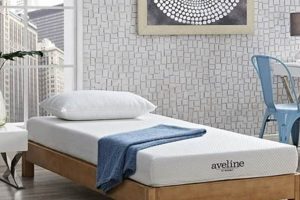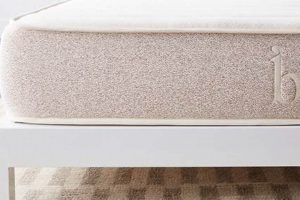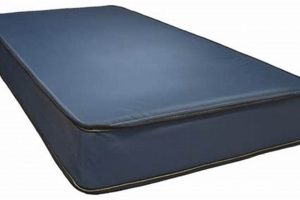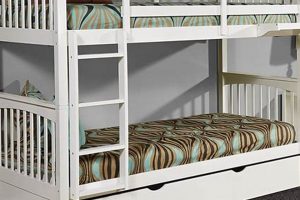A standard bed size, commonly utilized in bunk bed configurations, offers a compact sleeping surface for individuals. These mattresses, typically measuring approximately 39 inches wide and 75 inches long, provide a space-saving solution, especially in shared bedrooms or smaller living quarters. They are designed to fit securely within the frame of a bunk bed, ensuring safety and stability for the occupant.
The prevalence of these sleeping arrangements stems from their ability to maximize floor space, an essential consideration in dormitories, children’s rooms, and vacation homes. Furthermore, the design often incorporates safety features, such as reinforced edges and materials meeting specific flammability standards. Historically, these types of beds have been employed in situations where space is limited, evolving from simple cots to more sophisticated and comfortable designs.
Considerations for selecting the optimal sleeping surface include factors such as mattress thickness, material composition (e.g., memory foam, innerspring, latex), and intended user weight and sleeping preferences. Evaluating these attributes is crucial to ensuring a comfortable and supportive sleep experience. This article will delve into various aspects related to selecting, maintaining, and optimizing these mattresses for a safe and restful environment.
Essential Considerations for Bunk Bed Mattresses
Selecting the appropriate mattress for a bunk bed requires careful consideration of several factors to ensure safety, comfort, and longevity. The following tips outline key aspects to evaluate.
Tip 1: Measure the Bunk Bed Frame: Prior to purchasing a mattress, accurately measure the interior dimensions of the bunk bed frame. This ensures a proper fit, preventing the mattress from shifting or creating hazardous gaps.
Tip 2: Prioritize Safety Standards: Verify that the chosen mattress meets or exceeds relevant safety standards, including flammability regulations and guidelines for bunk bed mattress thickness. Thicker mattresses may compromise the safety rail height.
Tip 3: Evaluate Mattress Thickness: Bunk beds typically have height restrictions. The mattress should be thin enough to maintain a safe distance between the top of the mattress and the top of the guardrail. Consult the bunk bed manufacturer’s recommendations for maximum mattress thickness.
Tip 4: Consider Mattress Material: Various materials, such as innerspring, memory foam, and latex, offer different levels of support and comfort. Select a material that aligns with the sleeper’s preferences and any specific needs, such as pressure relief or temperature regulation.
Tip 5: Assess Weight Capacity: Ensure that the chosen mattress can adequately support the weight of the intended user. Overloading the mattress can compromise its integrity and reduce its lifespan.
Tip 6: Opt for Durable Construction: Look for mattresses with reinforced edges and high-quality materials. Durable construction enhances longevity and prevents premature sagging or deformation.
Tip 7: Consider Airflow and Breathability: Especially for bunk beds, adequate airflow is important to regulate temperature. Mattresses with breathable materials can help prevent overheating and ensure a more comfortable sleep.
Choosing a suitable mattress for a bunk bed entails prioritizing safety, comfort, and durability. By carefully evaluating the frame dimensions, safety standards, thickness, material composition, weight capacity, and airflow, it is possible to optimize the sleep environment and provide a secure and restful experience.
The following sections will explore specific mattress types and maintenance strategies in greater detail.
1. Dimensions and Fit
The correlation between dimensions and appropriate fit is paramount when selecting a sleeping surface for bunk bed applications. The dimensional characteristics of a mattress directly impact its safe and effective integration within a bunk bed frame. A mismatch in dimensions can compromise safety and comfort, underscoring the importance of precise measurements.
- Accurate Measurement of Frame Interior
The initial step involves meticulously measuring the interior dimensions of the bunk bed frame. This ensures the selection of a mattress that corresponds precisely to the available space. Failure to accurately measure can result in a mattress that is either too large to fit or too small, leading to potential safety hazards and discomfort.
- Standard Dimensional Compliance
While referred to as “twin,” slight variations in manufacturing can occur. Verify that the chosen mattress adheres to standard nominal dimensions (approximately 39 inches wide by 75 inches long) or the bunk bed manufacturer’s specified requirements. Non-compliance can lead to instability and increased risk of accidents.
- Gap Mitigation
Optimal fit minimizes gaps between the mattress and the bunk bed frame. Excessive gaps can create entrapment hazards, particularly for children. Selecting a mattress that fits snugly within the frame reduces the risk of limbs becoming lodged between the mattress and the surrounding structure.
- Weight Distribution and Support
Proper dimensional fit contributes to even weight distribution across the mattress surface. An ill-fitting mattress may experience uneven wear and tear, leading to premature sagging or deformation. This compromises support and reduces the mattress’s overall lifespan.
The importance of dimensional precision extends beyond mere comfort; it is a critical safety consideration in bunk bed mattress selection. By adhering to accurate measurements and verifying compliance with dimensional standards, the risks associated with improper fit can be effectively mitigated. Prioritizing dimensional accuracy ensures a stable, safe, and supportive sleeping environment.
2. Thickness Limitations
Thickness limitations are a critical safety and functionality consideration in the context of these beds. The height of the mattress directly affects the effectiveness of the bunk bed’s safety rails, influencing the risk of falls and potential injuries. Understanding and adhering to these limitations is paramount for ensuring a secure sleep environment.
- Guardrail Height Compromise
An excessively thick mattress diminishes the protective function of the guardrail. Standard bunk bed designs incorporate a specific guardrail height intended to prevent occupants from rolling out of bed. When a mattress exceeds the recommended thickness, the available height of the guardrail is reduced, thereby increasing the likelihood of falls, especially during sleep.
- Ladder Accessibility Issues
Mattress thickness can also impac
t the ease and safety of accessing the upper bunk via the ladder. An overly thick mattress raises the sleeping surface, potentially making it more challenging for individuals to climb up and down the ladder safely. This increased difficulty can lead to instability and a higher risk of accidents, particularly for younger users. - Manufacturer Guidelines and Compliance
Bunk bed manufacturers typically provide specific guidelines regarding maximum mattress thickness to ensure compliance with safety standards. Adhering to these guidelines is essential for maintaining the integrity of the bunk bed design and preventing modifications that could compromise its structural stability. Deviation from these recommendations can void warranties and increase liability in case of accidents.
- Impact on Weight Distribution
While not a direct safety concern related to falls, excessive thickness combined with certain mattress materials may affect overall weight distribution on the bunk bed frame. This could place undue stress on specific points of the frame, potentially leading to premature wear or even structural failure over time. Selecting a mattress that adheres to thickness limitations while still providing adequate support is vital for the bunk bed’s longevity.
In summary, thickness limitations are inextricably linked to the safe and functional design of beds. Ignoring these limitations can result in compromised guardrail effectiveness, accessibility challenges, and potential structural issues. Strict adherence to manufacturer guidelines and a thorough understanding of the relationship between mattress thickness and bunk bed safety features are crucial for providing a secure and comfortable sleeping arrangement.
3. Material Composition
The selection of materials in the construction of these mattresses significantly influences safety, comfort, durability, and cost. Material composition dictates factors such as support, temperature regulation, hypoallergenic properties, and resistance to wear and tear, all critical considerations for a frequently used and often space-constrained sleeping environment. For instance, innerspring mattresses offer traditional support, while memory foam conforms to body contours. Latex provides a balance of support and breathability. Each material type possesses distinct characteristics that directly affect the sleeper’s experience. The choice of flame-retardant materials is also a critical aspect of material composition, influencing the mattress’s ability to meet safety regulations.
Specific examples highlight the practical significance of understanding material composition. A mattress constructed with low-density foam may quickly degrade under the weight of a child or young adult, reducing support and requiring premature replacement. Alternatively, a mattress utilizing non-breathable materials can trap heat, leading to discomfort and disrupted sleep. Individuals with allergies may require mattresses made with hypoallergenic materials such as latex or certain types of memory foam, minimizing exposure to allergens. Therefore, an informed decision regarding material selection is paramount for maximizing the benefits and minimizing the drawbacks associated with a sleeping surface in a bunk bed context.
In summary, the materials employed in a mattress’s construction exert a profound influence on its performance and suitability for bunk bed use. Considerations include the material’s impact on support, comfort, durability, safety, and potential allergenic effects. Understanding the inherent properties of various materials allows for a more informed selection process, leading to a more comfortable, safer, and longer-lasting mattress that meets the specific needs of the intended user and the constraints of the bunk bed environment.
4. Support and Comfort
Support and comfort are intrinsic elements in the selection of any sleeping surface, and their importance is amplified within the constraints of a bunk bed environment. The dimensions and structural characteristics of bunk beds necessitate a careful evaluation of how a mattress contributes to spinal alignment, pressure relief, and overall sleep quality. Selecting a mattress that adequately addresses both support and comfort is crucial for promoting restful sleep and preventing potential musculoskeletal issues.
- Spinal Alignment and Posture
A mattress with inadequate support can lead to improper spinal alignment, resulting in discomfort and potential back pain. The mattress should conform to the body’s natural curves, providing sufficient support to maintain a neutral spine position during sleep. In the bunk bed context, where space is limited, a mattress that effectively promotes spinal alignment is paramount for ensuring comfortable and healthy sleep.
- Pressure Point Relief
Prolonged pressure on certain areas of the body can lead to discomfort and disrupted sleep. A mattress that effectively distributes weight and minimizes pressure points can significantly enhance comfort. Materials such as memory foam and latex are known for their pressure-relieving properties, making them suitable choices for use with a bunk bed, where individuals may spend extended periods in a confined space.
- Material Firmness and Personal Preference
The optimal level of firmness is subjective and dependent on individual preferences and sleeping positions. Some individuals prefer a firmer mattress for enhanced support, while others prioritize a softer mattress for increased comfort. Selecting a mattress with a firmness level that aligns with personal preferences is essential for maximizing sleep quality and satisfaction within the bunk bed setting.
- Long-Term Sleep Health
Consistent lack of support and comfort can contribute to chronic sleep deprivation and related health problems. A well-chosen mattress promotes restful sleep, allowing the body to recover and rejuvenate. Investing in a mattress that prioritizes both support and comfort is a long-term investment in overall health and well-being, particularly important for individuals who regularly sleep in bunk beds.
The facets of spinal alignment, pressure relief, firmness preference, and long-term health all converge to underscore the critical role of support and comfort in the context of these mattresses. The limited space and specific safety requirements associated with bunk beds make careful mattress selection essential for promoting restorative sleep and preventing potential health concerns. By prioritizing both support and comfort, individuals can maximize the benefits of this compact sleeping arrangement.
5. Safety Compliance
Safety compliance is an indispensable element in the design, manufacture, and use of a particular size of mattress often purposed for bunk beds. These mattresses, due to their specific application in elevated sleeping structures, necessitate strict adherence to established safety standards to mitigate potential risks of injury. Non-compliance can result in scenarios involving falls, entrapment, or exposure to hazardous materials. For instance, the flammabilit
y of mattress materials is regulated by law, requiring manufacturers to use fire-resistant components or treatments. Failure to comply with these regulations can have severe consequences in the event of a fire. Additionally, the structural integrity of the mattress itself contributes to overall safety. Mattresses that do not meet minimum standards for firmness and support can increase the risk of suffocation, particularly for young children.
Practical applications of safety compliance are evident in mattress labeling, construction techniques, and testing protocols. Mattress labels are required to clearly indicate compliance with relevant safety standards, providing consumers with essential information. Manufacturers often employ reinforced seams and durable materials to enhance the mattress’s structural integrity, reducing the risk of tears or collapses. Rigorous testing procedures are implemented to evaluate the mattress’s resistance to fire, impact, and compression. These tests ensure that the mattress can withstand normal use and potential hazards without compromising safety. Moreover, compliance extends to the bunk bed structure itself, requiring appropriate guardrail heights and ladder designs to prevent falls. The mattress must integrate seamlessly with these features to create a secure sleeping environment.
In summary, safety compliance is not merely a regulatory requirement but an ethical imperative for manufacturers of sleeping surfaces. Understanding the intricate relationship between mattress design, bunk bed structure, and established safety standards is crucial for preventing accidents and protecting occupants. Challenges remain in ensuring consistent enforcement of regulations and educating consumers about the importance of safety-certified products. By prioritizing safety compliance, manufacturers and consumers alike contribute to creating a secure and comfortable sleep environment within the inherent constraints of elevated beds.
Frequently Asked Questions
This section addresses common inquiries regarding mattresses designed for bunk bed use, providing clarification on safety, suitability, and selection considerations.
Question 1: Is a specific type of mattress required for bunk beds?
While a standard mattress of appropriate dimensions may fit, it is crucial to adhere to the bunk bed manufacturer’s guidelines regarding maximum mattress thickness. Overly thick mattresses can compromise the safety rail height, increasing the risk of falls.
Question 2: What is the typical thickness range for bunk bed mattresses?
The recommended thickness generally ranges from 5 to 8 inches. However, the optimal thickness is contingent upon the specific design of the bunk bed and the height of its safety rails. Consulting the manufacturer’s specifications is essential.
Question 3: Are there specific safety standards for mattresses intended for bunk beds?
While no singular standard explicitly governs bunk bed mattresses, compliance with general mattress flammability regulations (e.g., 16 CFR Part 1633 in the United States) is mandatory. Furthermore, the Consumer Product Safety Commission (CPSC) provides guidelines for bunk bed safety, including recommendations for guardrail height and mattress support.
Question 4: Can any type of mattress material be used on a bunk bed?
While innerspring, memory foam, and latex mattresses are all viable options, the choice of material should consider factors such as weight capacity, support requirements, and potential for heat retention. Breathable materials are generally preferred to promote airflow and prevent overheating.
Question 5: How does mattress weight affect bunk bed safety?
Excessive mattress weight can place undue stress on the bunk bed frame, potentially compromising its structural integrity. It is crucial to verify that the combined weight of the mattress and occupant does not exceed the bunk bed’s weight limit, as specified by the manufacturer.
Question 6: What are the potential consequences of using a mattress that is too thick for a bunk bed?
Using a mattress exceeding the recommended thickness can significantly reduce the effectiveness of the guardrails, increasing the risk of falls. Furthermore, it can impede access to the upper bunk via the ladder, potentially leading to accidents.
Selecting an appropriate mattress for bunk bed use involves careful consideration of thickness limitations, safety standards, and individual needs. Prioritizing safety and adhering to manufacturer guidelines is paramount.
The subsequent sections will explore maintenance strategies to extend mattress lifespan.
Conclusion
This article has comprehensively explored the dimensions, safety considerations, and material properties associated with the term. Adherence to safety standards, appropriate thickness selection, and consideration of material composition are critical factors in ensuring a safe and comfortable sleep environment. The longevity and structural integrity of both the mattress and the bunk bed frame are directly influenced by these considerations.
The information presented herein serves as a guide for informed decision-making, aimed at promoting occupant safety and optimizing the performance of these compact sleeping arrangements. Further research and adherence to manufacturer guidelines are strongly encouraged to ensure the continued safe and effective utilization of this common bedding configuration.





![Best Walmart Twin Size Blow Up Mattress [Guide] Organic & Natural Mattress Buyer’s Guide: Non-Toxic Sleep Solutions Best Walmart Twin Size Blow Up Mattress [Guide] | Organic & Natural Mattress Buyer’s Guide: Non-Toxic Sleep Solutions](https://mattressworldpa.com/wp-content/uploads/2025/07/th-5075-300x200.jpg)

